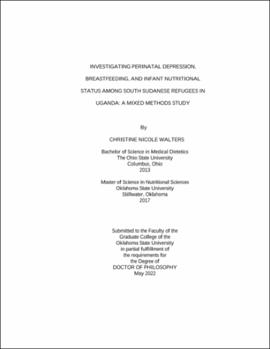| dc.description.abstract | Mothers in refugee settlements face challenges, including an increased risk of developing perinatal depression as well as complex barriers to breastfeeding. Issues of food insecurity and child undernutrition are common. Evidence suggests an association between maternal mental health status, breastfeeding practices and infant nutritional status exists. However, associations have been scantly studied among refugees and the scope of perinatal depression among refugees in Uganda is unknown. The purpose of this mixed-methods study was to investigate perinatal depression, breastfeeding, and infant nutritional status among South Sudanese refugees in Uganda. Qualitative data were collected through focus group discussions and in-depth individual interviews. Quantitative data collection occurred during a community based, longitudinal, randomized controlled trial. Six perceived common stressors were: lack of basic needs, issues involving childbirth, marital conflict and violence, other violence and conflict, inadequate health care, and issues involving children. Parents responded to stress by contacting leaders/authorities, talking to others, healthy coping skills, and unhealthy coping skills. Participants perceived the community could organizing community discussions, leadership, economic opportunities, recreational opportunities, and counseling. Breastfeeding barriers included: knowledge, physical, socioeconomic, and psychosocial. Beliefs and knowledge about breastfeeding benefits, support from husband/father, the community, and non-governmental organizations were facilitators of breastfeeding. During pregnancy, 70.3% of mothers had depressive symptoms and 19.9% had antenatal depression. Nearly a quarter (23.5%) had postpartum depression and 62.3% reported depressive symptoms. Over half (66.6%) breastfed within one hour of birth and 55.5% exclusively breastfed their infants. Among infants, 11.9% were underweight, 12.8% were stunted, and 7.1% were wasted. No association was determined between antenatal depression and breastfeeding practices or undernutrition. In adjusted analyses, mothers who met the criteria for postpartum depression were less likely to breastfeed within an hour of birth and less likely to exclusively breastfeed. Initiating breastfeeding within an hour after delivery and exclusively breastfeeding both significantly reduced the odds of developing postpartum depression. Early postpartum depression symptoms predicted significantly lower weight-for-age scores and lower length-for-age scores. These results indicate a connection between postpartum depression, breastfeeding, and infant nutritional status. Screening and treatment for perinatal depression during antenatal and postnatal care is important. Interventions aiming to improve breastfeeding among refugees may also consider including initiatives to address postpartum depression. | |
